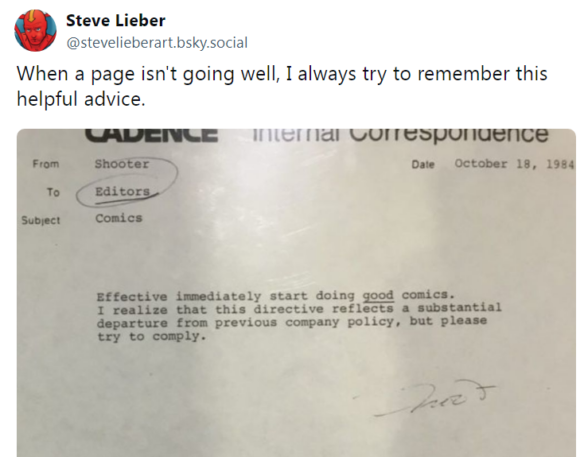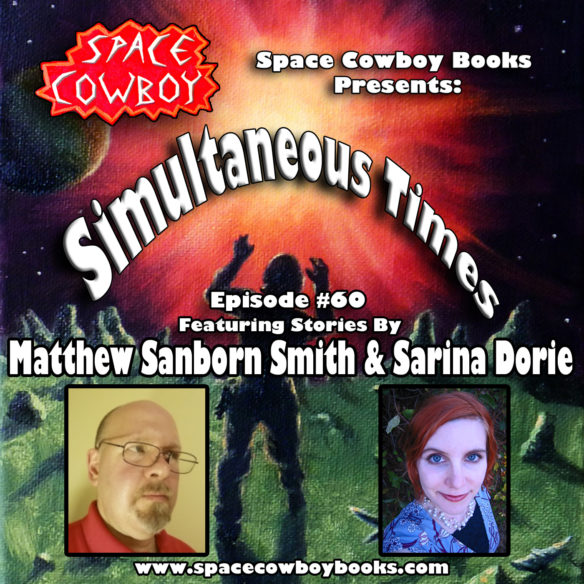(1) HOLMES & WATSON. At Brandon O’Brien’s Afternoon Tea the author takes up the Elementary series: “Lapsang Souchong: Two People Who ‘Love’ Each Other”.
I’ve been thinking about this topic idly in my skull for quite some time, and since there are no real good places to put it—less than an essay, more than a tweet—I figured a good test of my discipline would be drafting it for a newsletter. So here’s me rambling about one of my favourite idle obsessions: the 2010s CBS procedural Elementary, in particular why its portrayal of the relationship between Holmes & Watson is one of my favourites. BIG SPOILERS, of course that goes without saying, but you’re already here, so…
(2) TINGLE Q&A. The Geekiary came back from the con with more proof that love is real! “WonderCon 2024: Interview with the Legendary Chuck Tingle”.
… “You don’t hear this so much anymore, but back in the day, conservatives had this sort of slippery slope dang baloney argument about ‘if we let gay people get married then what’s next? You gotta marry a tree? Are you going to marry a dang dinosaur?’ And I think that I always heard those arguments and I always thought why not? What would be wrong with someone marrying whoever, whatever, how many different people, different combinations. There’s nothing wrong with that. In fact, as long as you’re talking about consenting adults, the world would be a much better place if you took this conservative nightmare to the extreme, it would actually probably be more of a utopia.
“And so the Tingleverse in general, is kind of that conservative nightmare realized in that actually, it would be a really beautiful place full of love, and acceptance. And so, from the very first story, it is an unusual combination of lovers. But you realize if you read the book, ‘Oh, actually, that’s a really wholesome, beautiful, wonderful place that conservatives seem to just be terrified of.’”…
(3) “TRAD PUBLISHING IS LITERALLY FAILING AT DOING ITS JOB”. Lili Saintcrow cuts loose about the current WTF state of traditional publishing — “We Gotta Talk About (Trad) Publishing”. (Saintcrow’s fireworks are inspired by Lorraine Wilson’s analysis, “Is there a book submission arms race”, an article that Saintcrow praises as “perfectly lovely and … a hundred percent accurate”.)
…Publishing has always been an awfully exploitative business. For a long while the level of fuckery in trad pub was low enough for plenty of writers to make a reasonable gamble by submitting by the rules and building a career, but this is no longer the case. Which is not solely or even mostly a function of the pandemic, mind you–the problems were already there well before 2020 rolled around, but conditions since ~2016 have absolutely poured jet fuel on the fire and now we’ve got a multiple-alarm blaze. (You could even trace the problems to Amazon’s strong-arming, or further back to Reagonomics, but that’s a whole ‘nother blog post.)
The Big Five/Four have already offloaded the brute work of marketing onto individual authors, hollowing out their own marketing departments in order to line C-suite pockets. Now the crunch has reached editorial departments, where even salaried folk traditionally protected from a lot of industry bullshit are being ruthlessly overworked, underpaid, and just generally mistreated. (No, this is not a “pity the poor editors” screed, just a fact.) Consequently a lot of folk are leaving, and those who remain–or the shiny new ones coming in, thinking they’re going to score a good job–find it impossible to pick up the slack. The article linked above is absolutely correct that editors at the big houses are now being used as draft-horse project managers, which does not work with novels or nonfiction books. It just…doesn’t….
And there’s a lot more at the link.
(4) IN THE YEAR 2025. The 2025 UK Eastercon – named Reconnect — will be held April 18-21, 2025 in Belfast, co-chaired by James Bacon and Tommy Ferguson, with Deputy Chair Jo Zebedee. Get more information at the Eastercon Belfast website.

(5) GLASGOW 2024 PUBLISHES NEW PROGRESS REPORT. Glasgow 2024 today published Progress Report 4 (their fifth; the first was numbered as Progress Report 0). Anyone can download the PDF file from the Glasgow 2024 website.
The cover for Progress Report 4 (PR4), ‘Badger Finds A Charmawow’ is by Chris Baker (a.k.a. Fangorn), one of the Guests of Honour.
PR4 includes news from all areas including:
- An update from Convention Chair Esther MacCallum-Stewart
- Our updated membership rates including rates for day tickets
- Ways to support the convention through our Community Fund and sponsorship opportunities
- An interview with Special Guests Three Black Halflings
- More information on our major Events, including newly announced performances by The Irish Video Game Orchestra and The Scottish Falsetto Sock Puppet Theatre
- An introduction to the Memorial Garden where they will honour friends and loved ones who have passed on
- An update from Guest of Honour Terri Windling, who will be presenting an exhibition of work by Dartmoor Mythic Arts at the convention
- Further news and updates from all Divisions as the convention comes ever closer.
PR4 also features a look back at the London Worldcon of 2014, the final entry in their history of British Worldcons.
(6) WILL GLASGOW CAP ATTENDING MEMBERSHIPS? Progress Report #4 includes this information:
… Our current projections are for between 6,500 and 8,000 purchased in-person registrant types (including 1- and 2-day tickets). This upper number, if everyone turns up, is probably above the maximum holding capacity for the site. So, there is a chance we may need to cap in-person attending registrant purchases, if we are not to get overcrowded. So, we are advising folk to join as early as possible to avoid this possibility effecting your enjoyment of the convention….
(7) TEXAS-SIZED COLLECTION. Morgan Dawn recommended Bluesky readers watch a 2022 video about the “Huge Science Fiction and Fantasy Collection”, which explores the sff collection at the Texas A&M Library, and takes viewers back to the early days of the university’s Cepheid Variable club and their annual AggieCon.
(8) A BELFAST BOOK. “Michael Magee: ‘There’s a disbelief at how I’ve ended up’”, so he tells a Guardian interviewer.
Michael Magee, 33, won this year’s Nero debut fiction award for Close to Home, now out in paperback, as well as last year’s Rooney prize for Irish literature (previously awarded to Anne Enright and Claire Keegan). Set in west Belfast, where Magee grew up, the book follows Sean, a working-class graduate who falls foul of the law as he struggles to make a life in the shadow of violence both political and domestic….
What did you read growing up?
In my later teens I had a very good English teacher who gave me Barry Hines’s A Kestrel for a Knave, which was the first instance where I’d read something that reflected my own reality. I didn’t grow up in a bookish house and didn’t start reading in my spare time outside education till I was about 12 or 13. Lord of the Rings was my gateway drug. As a teenager I wrote a ripoff of it, drawing maps that I dabbed with wet teabags and burned at the edges to age them. But I did all this on the shy! You couldn’t be seen reading books in the company I was keeping. As a young man I felt impelled towards toughness, inexpressiveness, which was at odds with who I was, and who I am. It took me a very long time to disentangle myself from that.
You must run into people who knew you back then.
Of course, all the time. There’s a disbelief at how I’ve ended up – I ask myself the same question – and also a kind of piss-taking, which is completely deserved: “Still writing your wee books, Mick, are ye?”…
(9) IF YOU GIVE A MOUSE A BATH. Forbes believes they know “The Real Reason For Disney’s $11 Billion Streaming Losses”.
… For a number of months in 2020, Disney was almost entirely reliant on Disney+ and it came into its own. As people were stuck indoors during lockdown, the popularity of the platform surged and was hailed as Disney’s white knight. It was almost unthinkable that it could actually end up bringing the company to its knees but that is exactly what happened over the following years.
As subscriber numbers soared far beyond Disney’s forecasts, the Mouse got drunk on its own success and ploughed billions of Dollars into exclusive Disney+ content. By the time it was released, there was a vaccine for covid and the pandemic had receded. Consumers were left picking up the tab for blockbuster furlough payments creating a global cost of living crisis that endures to this day. It led to people cutting their streaming subscriptions and left Disney with a loss-making platform….
(10) TODAY’S BIRTHDAY.
[Written by Cat Eldridge.]
Born April 7, 1934 — Ian Richardson. (Died 2007.) I do these Birthdays by seeing who I recognize and then doing a deep dive to see how interesting a given individual is. It’s not just what they did in our community that interests me but what they’ve done else as well. And Ian Richardson had an interesting career both here and elsewhere.

Where to start? He was at the right age, just about fifty, when he played Holmes in The Sign of Four and The Hound of the Baskervilles, a pair of made for television films. He also starred in BBC’s Murder Rooms: The Dark Beginnings of Sherlock Holmes playing Arthur Conan Doyle’s mentor, Dr. Joseph Bell.
What next? How about him being in Brazil? (I had to watch it three times before I liked it.) He plays Mr. Warren, works in a rabbit-warren style place, a maze of Endless Corridors. A perfect bureaucrat he was.
He’s the Narrator of Dark City which was nominated for the Hugo Award at Aussiecon Three the year The Truman Show won.
In Rosencrantz & Guildenstern Are Dead, he’s Polonius. In the play by Shakespeare, Polonius is a verbose, faltering and pathetic old man whose servile devotion to Claudius renders him untrustworthy in the eyes of Hamlet. Here he portrays that character perfectly. Yes, I do love the film.
He’s The Wasp in Alice Through The Looking Glass. You really, really need to see the yellow wig that they gave to represent him being a wasp.

He’s in From Hell as Sir Charles Warren, an actual historical figure, an Officer in the British Royal Engineers who was one of the first archaeologists.
Finally he’s in that Midsummer’s Night Dream. You know the one that Ian Holm, Helen Mirren, Diana Rigg, David Warner and Judi Dench in it? He plays Oberon here.
Wait, though, as I do feel obligated to note his two extraordinary performances outside the genre. He played Tory politician Francis Urquhart in the House of Cards series — oh so magnificently — and he was British spy Bill Haydon in the Tinker Tailor Soldier Spy series.
(11) COMICS SECTION.
- Thatababy has celebrity neighbors.
- Wallace the Brave has a secret long distance language.
- Carpe Diem features the economy class of the future.
- Bizarro knows the timeless appeal of selfies.
- Dog Eat Doug has an extravehicular excursion.
(12) YES, YOU. Steve Lieber shared an unforgettable memo from Jim Shooter to the staff.

(13) THEY MADE THE SHIP THAT MADE THE KESSEL RUN. [Item by Steven French.] Atlas Obscura tells us the genre connection of Wales’ “Pembroke Dock Heritage Centre”.
THERE WAS SOMETHING DIFFERENT ABOUT the last ship to leave Pembrokeshire’s massive dock complex.
Following the success of the original Star Wars film in 1977, director George Lucas wanted a full-scale model of Han Solo’s fabled spaceship, the Millennium Falcon, for the filming of the next installment in the series, The Empire Strikes Back.
The job of constructing the 88-foot vessel fell to a team working out of the historic maritime dock complex at Pembroke Dock, Pembrokeshire…
Sadly, the model was sold for scrap.
(14) MAKE YOUR SPEED WORF FACTOR THREE. [Item by Dann.] “From the Starfighter to the Enterprise NCC-1701-D” in FLYING magazine.
From the late 1980s through the 1990s, Klingon Lt. Cmdr. Worf was one of the most visible characters on the popular TV shows Star Trek: The Next Generation and Star Trek: Deep Space Nine. Actor and pilot Michael Dorn, who was cast as Worf, made the character his own and ended up appearing in 276 episodes, the most of any other cast member in the Star Trek franchise’s history.
To Dorn, morphing into Worf each day was a lengthy process because of the amount of makeup and prosthetics required to bring the character to life. But when the cameras stopped rolling, it wasn’t the starship Enterprise that drew Dorn’s attention, it was a Cessna 172 Skyhawk. But there was a problem.
You see, Michael Dorn likes airplanes that go fast. Really fast. After moving through a few general aviation airplanes, he began buying and flying a long list of former U.S. military fighter jets. This desire to go fast also explains why he drives a Tesla Model X P100D today. “It has ‘Ludicrous’ mode,” Dorn says. “I live for on-ramps!”…
The list of aircraft Michael has owned includes:
Civilian aircraft
- Cessna 172
- Cessna 310
- Cessna 340A
- Citation 501SP
- SOCATA Trinidad TB-20
- Beechcraft Baron 55
Military (or military-grade) aircraft
- HA200 Saeta (Spanish and Egyptian Air Forces)
- Lockheed T-33 (USAF, USN, Japanese Air Self-Defense Force, German Air Force)
- North American F-86C (USAF, Japan Air Self-Defense Force, Spanish Air Force, Republic of Korea Air Force)
- North American Sabreliner 40A (USAF, USN, & USMC operated military configurations)
- Lockheed F-104 Starfighter (USAF, German Air Force, Turkish Air Force, Italian Air Force)
(15) TRUE GRIT. “Life Beyond Earth: What Awaits Humanity on the Moon” – Literary Hub makes it sound a lot less fun than Robert A. Heinlein used to.
…Moondust is a huge problem. Apollo astronauts were vexed by the sharp-edged powder, which got under their fingernails and into their noses, lungs, mouths, and eyes. Apollo 12’s Alan Bean said residual dust in the LM cabin “made breathing without the helmet difficult, and enough particles were present… to affect our vision.” The stuff is like “silty sand… [but] sharp and glassy,” according to the Lunar Sourcebook. Coughing and itching are nuisances, but simulated long-term exposure, in one study’s words, revealed “significant cell toxicity in neuronal and lung cell lines in culture, as well as DNA damage.” Mitigating the dust is a significant challenge, but astronauts and their equipment could be protected with invisible electrodes that activate what researcher Carlos Calle calls an “Electrodynamic Dust Shield”—shifting electric fields that keep the dust from sticking to a surface…
(16) NASFiC ECLIPSE. Joseph T. Major reminds us about a previous celestial experience:
In 2017, too late to do anything about it, Mike Glyer had an interesting thought. Why not have NASFiC in Nashville, during the August 21 eclipse? But Ken Moore, the man who could have organized it, had died in 2009.
Nevertheless, there was a possibility. Bob Embler annually held Outsidecon, where fans got in tent and socialized. What was so important about that?
Every year, in Kelly, Kentucky, there is Little Green Men Festival, commemorating the close encounter there in 1955. In 2017, the Festival ran a day over, so the flying saucer people could see the eclipse. And they stayed in tents, too, because hotel bills were $300 a day and a minimum of three days’ stay.
If Mike and Bob had got together, they could have organized a Kelly Outdoor NASFiC bid for the 18th through the 21st. Now that would have been better than the San Juan NASFiC.
(17) VIDEO OF THE DAY. Elle Cordova delivers “Real footage of the #eclipse”.
[Thanks to Cat Eldridge, SF Concatenation’s Jonathan Cowie, Steven French, Dann, Bruce D. Arthurs, Kathy Sullivan, Mike Kennedy, Andrew Porter, John King Tarpinian, and Chris Barkley for some of these stories. Title credit belongs to File 770 contributing editor of the day Jon Meltzer.]



